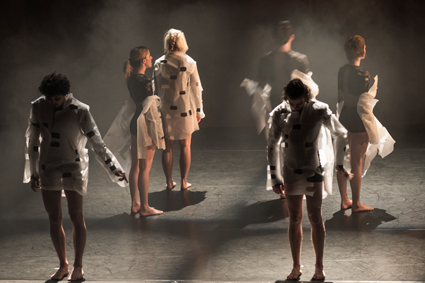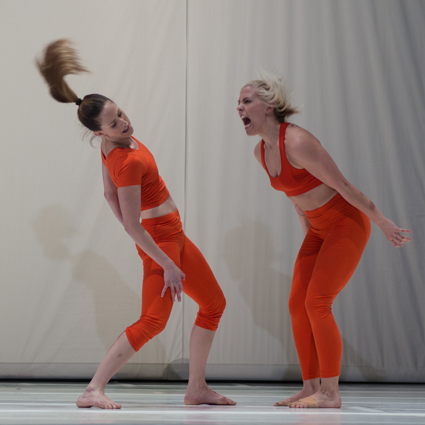in the wake of the singularity
judith abell: tasdance, voltage

Tasdance, A Human Calculation, Anna Smith
photo Jen Brown
Tasdance, A Human Calculation, Anna Smith
A MESH SCREEN RISES AT THE REAR OF THE STAGE REVEALING A SPACE BEYOND FORMED ENTIRELY FROM ‘THICK’ GREEN LIGHT. TWO MALE DANCERS WALK BACK INTO THE DEPTHS OF THE SPACE, SEEMING TO DISAPPEAR WITHIN ITS GLOW. WHILE THIS MOMENT OF THEATRE IS TECHNICALLY SIMPLE, THE ILLUSION IS COMPELLING IN ITS EXECUTION. I CATCH MY BREATH. IT IS JUST ONE OF MANY STRONG IMAGES IN A WORK CHOREOGRAPHED BY ANNA SMITH IN TASDANCE’S VOLTAGE SEASON.
Taking the idea of voltage as a starting point, choreographers Larissa McGowan and Anna Smith have each prepared a work for six dancers, titled Transducer and A Human Calculation respectively. McGowan has taken a more direct approach to the concept, by exploring the effect of energy on the body, the duo and the group, while Smith’s work reflects a fascination with the impact of technology on the human race.
Transducer opens with strobing light and each of the dancers silhouetted against a full height scrim forming a corner between the rear and side of stage. Both the set and the costumes are stripped back to basics, with the scrim a blank white, the dancers clothed in variations of loose or fitted orange lycra. It feels like an exploratory work that may have been developed entirely in collaboration with the dancers and composer. The ‘twitch’ of electricity is the link between really interesting solos or duets and more conventional group movement. I’m completely taken by a series of duets where one dancer appears to roar or scream at the other, mouth fully open, syncing exactly with the soundtrack of industrial noise, the other’s body moving involuntarily in response. I note that the two male dancers with their fierce, loose movements seem to portray this effect even more vehemently than their female mirror images.

Tasdance ensemble, Tranducer, Larissa McGowan
photo Jen Brown
Tasdance ensemble, Tranducer, Larissa McGowan
While McGowan’s reads as a workshopped piece, Smith conveys a sense that every detail has been considered and every image composed. She is playing with the apocalyptic idea (borrowed from Ray Kurzwell) that society will reach a point of “singularity” in 2045 when the speed of technological change causes a rupture in “…the fabric of human history” [when technological “superintelligences” will outstrip human intellectual abilities. Eds]. Her dancers appear lost in the afterglow of this moment, as though trying to reclaim a way to move or behave. A repeated movement throughout is of pulling forward and being drawn back, as though continually failing. The costumes, lighting and set pull together to form an intimate, moody work that is full of memorable, almost filmic images. Six dancers frozen in formless, laser-cut paper shifts, backlit like translucent lamps, provides one such moment.
Two-choreographer seasons have generally produced good results for Tasdance and obviously offer a productive challenge for their dancers. The works in Voltage are really interesting in themselves, but the double billing disadvantages choreographers clearly at different points in their careers. In this work McGowan is still evolving her choreographic language, while Smith appears at ease with the movement and is more focused on the developing the imagery of an idea. Consequently the more experimental work, Transducer, cannot hold its own against the more confidently shaped A Human Calculation.
Tasdance, Voltage, Transducer, choreographer Larissa McGowan, music Charlie Chan, A Human Calculation, choreographer Anna Smith, dancers Tobiath Booth Remmers, Ben Chapman, Sarah Fiddaman, Brianna Kell, Jenni Large, Tim Walsh, music Loscil, Scanner, Tim Hecker, Hauschka & Hildur Guðnadóttir, costumes Lexi George; design and lighting for both works Bluebottle–Frog Peck; Theatre Royal, Hobart, Aug 2- 3
RealTime issue #111 Oct-Nov 2012 pg. 34






